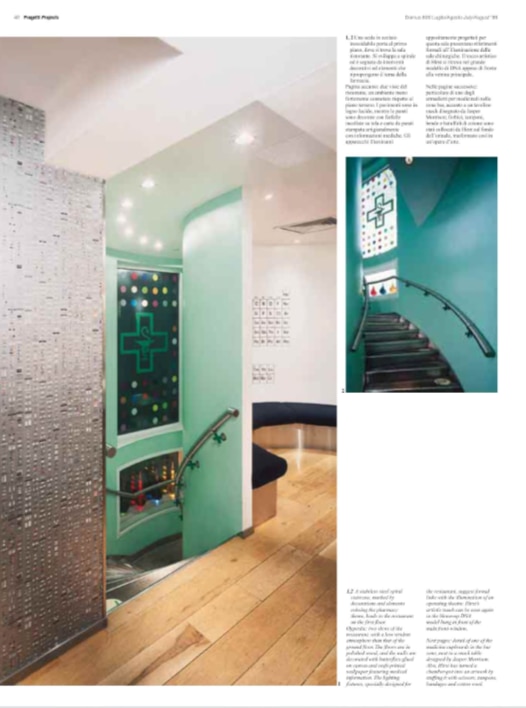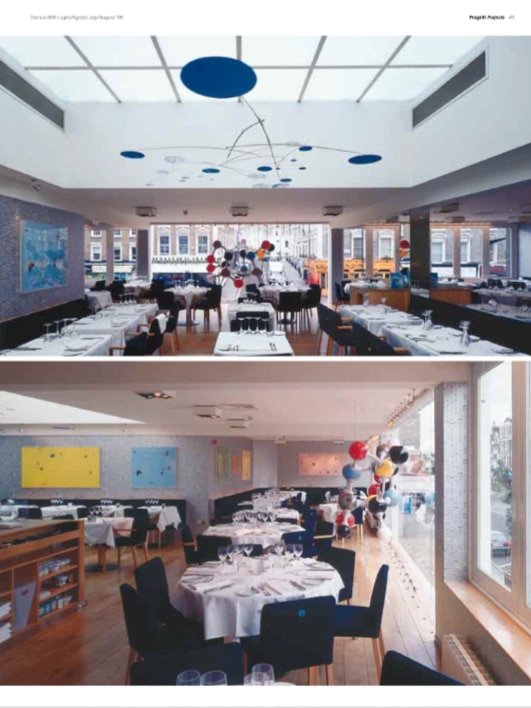By the end of the 1990s, Damien Hirst was already an artist who had placed himself in the highest positions on the global circuit, in terms of visibility and earnings: since 1988 when, with the group show Freeze, and with the support of gallerist Charles Saatchi, he and his schoolmates at Goldsmith including Tracey Emin and Ian Davenport formed the Young British Artists group, Hirst had been racking up awards and provocations that had made him a celebrity. In 1991 the Turner Prize had come, and The Physical Impossibility of Death in the Mind of Someone Living, the famous shark floating in a tank of formaldehyde.
In issue 806 of July 1998, Domus presented Pharmacy, Hirst's latest venture, a restaurant created in London with Mike Rundell and Jasper Morrison, and commenting on the project came a conversation between the artist and critic Pierre Restany: back into the pop era (?). Given the characters, one can only expect the exchange to be at the very least flamboyant.
.png.foto.rmedium.png)
Back into the Pop Era
Pierre Restany interviews Damien Hirst
I am glad to speak with you because here in continental Europe, especially in France and in Italy, we are fascinated by you as almost a kind of sociological phenomenon.
Sociological, wow!
Well, I just say that because right now you embody a trend in London, a kind of general atmosphere of creativity, of interchanges between people, in a very strong, compact and swift way. And that is very interesting: for us Continental Europeans you were absolutely unknown until 1993 and your participation in the Aperto section of the Venice Bienniale. Your piece caused a real sensation and soon after that we realized you were exactly illustrating a new wave in England. Now, in five years later, we are in 1998, well, I think that’s quite true. Your Pharmacy, for example, in Notting Hill, became the meeting point and show-room of this new wave. Through you London found a very quick way to reach a new pop feeling. You understand, what is fascinating for me is precisely this real change: in the first pop wave, the one of Lawrence Halloway with Peter Blake, Hamilton, Hockney, Allen Jones, the pace was slow, with a very intellectual kind of preparation till the final explosion; and in the second one, with you it became something very strongly existential, like a kind of rapid swing in life style.
I’m looking a bit differently at that. I mean, I think if you look at the kind of first one, with Peter Blake, if you imagine that the Beatles were part of that, then it seems small, I think. I mean, Peter Blake designed Sergeant Pepper’s, Richard Hamilton designed the White Album, and I think those kinds of cross-overs from pop music to pop art, to popular culture, were happening at the time, but people were aware that they were happening in an exciting way. I can just style the record companies as well, I can design record labels and do restaurants... I mean, what Richard Hamilton was doing with ashtrays and rings, advertising stuff, is not different from doing a restaurant.
.png.foto.rmedium.png)
In that way you feel close to the synthetic spirit of the first pop wave, don’t you?
I just like the word pop. Pop to me comes into art, something quite new in art, which is very exciting. I mean, art is popular, I didn’t invent that now, and I think art is a lot more popular today than it was then. I think there’s a lot more media coverage of art.
Of course, art is very strongly linked to all communication programmes; art is a synthetic dimension of communication and that can create swift changes.
First of all art is about life, and always has been, and the art world is about money, and always has been. I think in the Sixties the problem wasn’t the art, it was the art world, and I think because of the art it’s a lot easier for me to ignore the art world and to go home with the art. I think that if you centralize on the future like me, you can do whatever you want. As soon as you do that, it’s not very hard to imagine you can do a restaurant, record covers, a record company, fashion design, I mean, art can be anything and can go anywhere.
Tell me, what is the atmosphere of your Pharmacy restaurant? Do people come and enjoy the place, or are they a little overwhelmed by the design?
Not at all. I did everything to avoid that. For me function comes before aesthetics in a restaurant. Somebody came up to me while I was eating and said: “Ah, Mr Hirst, I just want to ask you what is this restaurant about?”. And I just said: “Shut up!” and he got dinner.

Do you feel that this kind of commitment of yours, this kind of style (I mean not doing exhibitions, but things that give you pleasure) is really understood and perceived by people as a new way of making art, of giving art another dimension?
I don’t know if people perceive it like that, but I do. I feel now like I did on my first day out of school, when you can do anything and it’s overwhelming, and it’s complicated and difficult and... you know, the possibilities of ways you could go are infinite... I mean, the possibilities are endless, and then before you know where you are you’ve got these machines surrounding you, encouraging you to make Damien Hirst and you think: “Why?”.
Do you think that a lot of people find your restaurant funny too, and enjoy it?
I think a lot of people enjoy it, but a lot of people in the art world are afraid of it really. I mean, when you run away with your idea of doing a restaurant, a lot of people think: “My God, he’s selling his name, he’s sold out, he has given up honour”, and you take a big gamble as well, because it’s very much in public, you can’t go to your studio and experiment and then, when you get it right, exhibit, you just get one chance.
You should be credited for the risks that you are taking, at least for that. Don’t you think so?
Also gallerists say: “You can undermine the prices of your work, you’re going to make your collectors nervous”. And I just think it’s all shit. Well, the thing is now they call me asking me if I can get them a table, which is fantastic. I mean, there’s a big difference between an ideal and reality, and I think everybody gets afraid of an ideal. Well, once it’s real they say, you know, when are we going to eat that dinner? I mean, I receive quite a lot of calls, people trying to book tables, every week. People call me, like gallerists, whom I haven’t heard for a long time, and they phone me to say: “How are you doing?”, and I think: “Why are they calling?” And then in the end they say: “Couldn’t you get me a table for Sunday night, could you, for five people?”

Do they ask you only that?
To be honest, the big thing that people so often ask me about is: as an artist you have to sell art in order to sustain a kind of life style, to make great art you have to pay otherwise you don’t make any, and so art was always very dangerous for an artist, because you have to make money. And the restaurant for me is like art: happily it’s full of people right now, as we speak, who are spending money and enjoying it and I’m going to position well. I don’t have to sell art to survive, which is a fantastic position to be in. It gives you a hell of freedom, which I think everybody needs.
What about the institutions? If they, for example, asked you for a major show in a museum, or may be to partecipate in a big event, like the one in Lisbon coming up, what would your reaction be?
I’ve no time. I mean, the thing is that I’m too busylooking forward to see how things are going on with a retrospective eye.
Do you work in close contact with any architects, designers or communication people?
I work with the designer Jasper Morrison.
Ah yes, Morrison, who did the Pharmacy with you.
Yes, I’m working with him, and with another friend who credits my book and is a designer. I find that when I work with somebody and like him, then we become friends.
Yes, you become friends, you can exchange ideas, they feel a little like you too. And do you think their coming in touch with you has changed their life?
Yes, definitely. If you think of the other furniture that Judd did. I mean, it looks great, but it is very uncomfortable. For me it is useful to work with designers. To design furniture I definitely want the designers. Because it isn’t comfortable, then it doesn’t work. I mean, aesthetics is great, but you have to cover the functional aspect of it first. For me Pharmacy is a project of this sort. I just want to make it a great place for people to be in. And all the people I work with want the same thing.
.png.foto.rmedium.png)
Do people stay long at your place, or do they eat quickly, in a very formal way?
No, it’s a beautiful room, it’s a great place to eat dinner. And they come back, and downstairs we have a bar which is rocking, which is like, you know... people vomiting and dropping glasses and dancing and chaos.
You are open till what time, midnight?
In the restaurant last orders are at midnight, and in the bar it’s two o’ clock in the morning or three. You know, the art work is constantly exposed to damage, there’s nothing you can do. You protect it as best as you can but... It’s like having a stampede through your exhibition every day. But that was what I wanted before we started. So everything, and the glass and the cabinets, are lockable, you know... But everything gets stolen and broken. At the beginning I said we are going to sell ashtrays and things like that, in order to cover the cost of people stealing them.
Do you think you will be able to keep up this kind of pace?
Yes, we are going to do one in Berlin next, Apotheke.
Well, I think Berlin is a good place to do that, especially now.
Yes, I go there every year and I’ve got friends there. And then a friend is to do the Paris bar. I mean, restaurants mean a lot to me. Whenever anything goes well in my life, I always say: “Come on, let’s go out for dinner”.
What kind of food do you like? French cooking, or Italian, or...
All of it. I cook myself.
You like, of course, wine and anything like that.
Yes, I love alcohol.
You are not a teetotaller.
No, I love all kind of alcohol. The more of it, the better.
I see you are greedy for life! I will come to London and see your Pharmacy just to feel if I can enjoy it. You understand, I appeal to you as a thermometer of a new life style.
I think if life was perfect, it wouldn’t need art.
(Note. London, Wednesday May 20 1998. Pierre Restany had dinner at the Pharmacy. Clean welcome and clean design, quick service, good Chilean wine, creative cooking: all ingredients required by the new Pop Yuppies for a trendy “piece of art”. Damien Hirst was not there).


